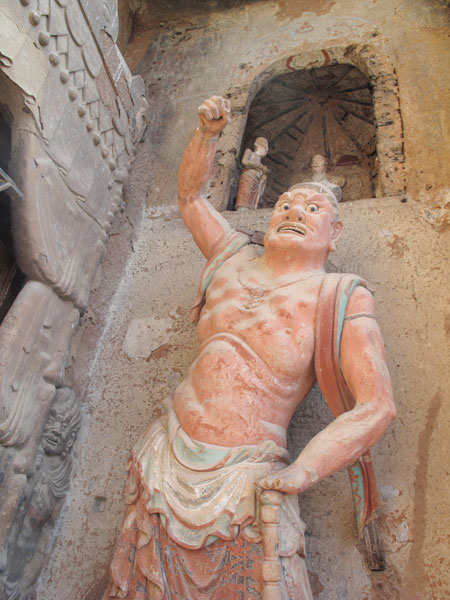
 'Taken 2' grabs movie box office crown
'Taken 2' grabs movie box office crown
 Rihanna's 'Diamonds' tops UK pop chart
Rihanna's 'Diamonds' tops UK pop chart
 Fans get look at vintage Rolling Stones
Fans get look at vintage Rolling Stones
 Celebrities attend Power of Women event
Celebrities attend Power of Women event
 Ang Lee breaks 'every rule' to make unlikely new Life of Pi film
Ang Lee breaks 'every rule' to make unlikely new Life of Pi film
 Rihanna almost thrown out of nightclub
Rihanna almost thrown out of nightclub
 'Dark Knight' wins weekend box office
'Dark Knight' wins weekend box office
 'Total Recall' stars gather in Beverly Hills
'Total Recall' stars gather in Beverly Hills
Heavenly grottoes
Updated: 2013-03-20 23:51
By Li Yang (China Daily)
|
||||||||
 |
|
While the paint has faded from most of the sculptures, the expressions on their faces will delight visitors. Li Yang / China Daily |
There are many big holes beside the huge grotto of the three great statues, about 0.5 meters in diameter and about 1 meter deep.
It is said ancient workers first dug these holes and inserted solid tree trunks to form various working platforms, like scaffolds. The holes were also used by repairmen and painters in later times to construct their working platforms.
The climb up the stairs, passing by the great statues, felt like a walk through a museum.
On the cliff surface 50 to 70 meters above the mountain foot are scattered about 194 caves with more than 7,200 pieces of Buddha sculptures and more than 1,000 square meters of frescos remain on the inner surface of the caves.
The most common pattern of the sculptures consists of a Buddha, sitting or standing, flanked by bodhisattvas and other attendants, or by monks or lay worshippers. The bodhisattvas on the Buddha's right are usually Avalokitesvara, and Mahasthamaprapta are on the Buddha's left. Pairs of dvarapala (gate guardian) or the four Heavenly Kings stand near the doorways to guard the Buddha and his entourage.
Some of the statues are as big as 5 to 6 meters tall and the caves they rest in are meters deep into the cliff. Some are only 50 to 60 centimeters tall and the caves are only as big as old-fashioned TV sets.
Some caves are lined up in good order with dozens or even hundreds of statues sculptured in the same fashion.
Although most of the paint has faded away, visitors can still verify their exquisite expressions on the face, each one different from another.
They have survived many earthquakes, natural and artificial disasters. They look alive and intelligent.
I stopped at almost every grotto to look into the cave through the guard bars. Compared with my hurried steps, all the statues demonstrate a kind of equanimity and calmness.
Although I could not see them clearly, the calmness, darkness, coolness and the sand rock smell greeted my ears, eyes and nose whenever I neared my head to the guard bars of some small caves. A mixture of inspirations filled my heart and the spiritual pull was undeniable.
Each groove on the statue today is a result of an ancient stonemason or a sculptor's delicate touch.
These caves, statues and frescos were created, maintained, or even damaged in more than 1,600 years of history.
Even if many statues are broken, leaving only remains, local people still worship them as cherished relics that can bring good luck and wisdom, as an old local woman told me at the end of my two-hour pilgrimage. She was kneeling down at the foot of the mountain praying for Buddha's protection.
With this in mind, I picked up four rocks beside my feet and put them into my backpack. They are now quietly resting on my bookshelf, and I hope they will bring me luck and wisdom.
Contact the writer at liyang@chinadaily.com.cn.
IF YOU GO:
Maiji Mountain, one of the country's national key scenic spots and places of historical interest, is located 45 km to the east of Tianshui city in Gansu province. The area covers 215 sq km with 180 scenic spots.
Entrance ticket is 70 yuan ($12). The opening time is from 8 am to 5 pm.
There are buses plying between downtown Tianshui and the mountain every 30 minutes. If you plan to visit all the scenic areas, you'd better set aside about four days for your trip and stay in a guesthouse run by local farmers.
If you plan to only visit the statues and caves, you should allocate about three to four hours for the 194 caves on Maiji Mountain.
Try to avoid touring during National Day holiday and Spring Festival. There will be too many tourists from around the country, and walking along the narrow stairs will become a nightmare, especially for those who want a leisurely visit.
- Longmen Grottoes will provide more convenient services for tourists
- Mogao Grottoes murals prepped for digital display
- Longmen Grottoes becomes ‘New Chinese Cultural Tourism Landmark’
- Longmen Grottoes scenic area rescues wild goshawk
- New historical sites to unveil in Longmen Grottoes Park in 2013
- Experts study Yungang Grottoes’ music-related carvings
Most Viewed
Editor's Picks

|

|

|

|

|

|
Today's Top News
Boston bombing suspect reported cornered on boat
7.0-magnitude quake hits Sichuan
Cross-talk artist helps to spread the word
'Green' awareness levels drop in Beijing
Palace Museum spruces up
First couple on Time's list of most influential
H7N9 flu transmission studied
Trading channels 'need to broaden'
US Weekly

|

|







